As the beer world waits to see whether this really is the end for the Anchor brewery in San Francisco, flagship for an entire beer style, a number of commentators have been suggesting – wrongly – that if anyone tries to carry on with Anchor, then it cannot be done outside San Francisco. There is also the curious, and effectively ignored, fact that steam beer, when it started, seems to have been a rather different drink to the one we know today, being sent out to bars along with a product called Flat Beer, for the two to be mixed together. But more of that shortly.
One of the problems in trying to unravel the history of steam beer is that for at least the first 30 years or so after the Gold Rush began in California and entrepreneurs rushed in to supply the hundreds of thousands of miners with their needs and wants, brewers on the Pacific coast generally called what they were brewing “lager”, though it was not cold-brewed, since ice was almost impossible to obtain. It was not until “real” lager arrived in the 1880s that a differentiation started to be drawn between the sort of warm-fermented beer made with lager yeast brewed, not just in San Francisco, or California, but up the Pacific coast from Nevada through Oregon, Washington and British Columbia to Alaska and Yukon, and even as far away as Quebec, and the cold-fermented lager beer brewed east of the Rockies.
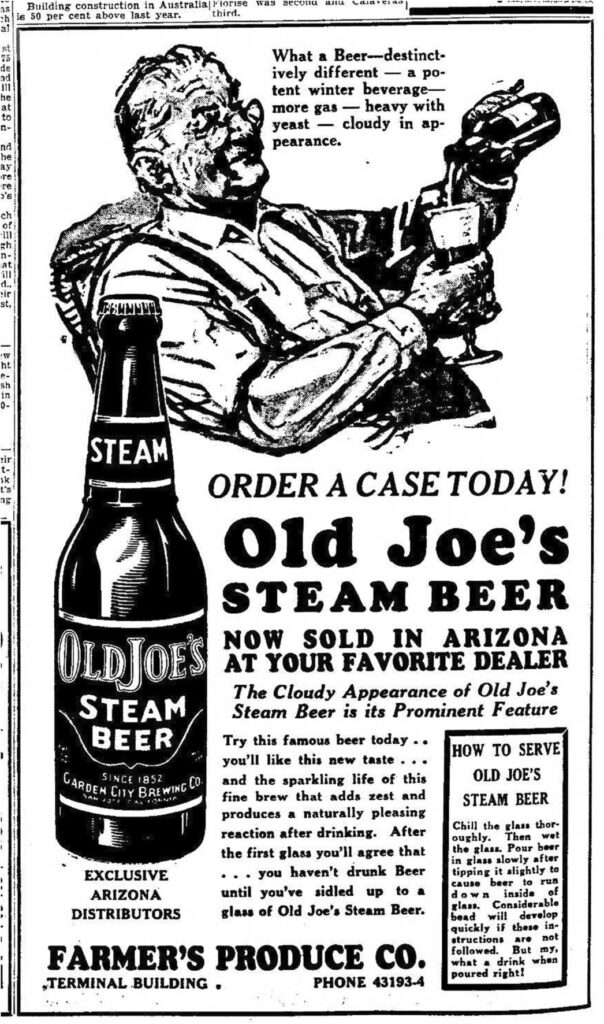
The major source for the early history of beer in the United States, a 700-page volume called One Hundred Years of Brewing, published in 1903, lists eleven of what it says were steam beer breweries in operation before 1860. Of these, just three were in San Francisco. The earliest listed was founded by Joseph Hartmann, a German immigrant, who started the first brewery in San Jose, 40 miles south of the Golden Gate, in either 1851 or 1852. When he began brewing, in a blacksmith’s shop, Hartmann was supposedly brewing just 25 to 50 barrels of steam beer a year. By 1905, when the brewery was being run by his son, Louis, it was making 25,000 barrels a year of Old Joe’s Steam Beer.
The second oldest steam beer brewery listed by One Hundred Years of Brewing, Philip Frauenholz & Co, founded by Philip Frauenholsz and Jacob Gundlach, was based in San Francisco, on Vallejo Street, but the third listed was founded by Frederick Walter in 1852 in Weaverville, a Gold Rush town 200 miles north, and the fourth, One Hundred Years of Brewing said, was founded in 1855 in Stockton, in the Central Valley, another Gold Rush town, and an important gold miners’ supply point.
When exactly the term “steam beer” came into use is unclear, but it seems to have been around from at least 1864, when a young Swiss German named Hemmann Hoffmann arrived in Virginia City, Nevada, a silver mining boom town 6,200 feet up in the mountains to the south of Reno. There he worked for a while for a fellow Swiss German, Jacob Riehm, first as a barman and then as a brewer at Riehm’s Pacific Brewery, on the edge of town, which was equipped with a 900-gallon (29-barrel) copper kettle that had been hauled the 370 miles by road from San Francisco. Hoffmann (who also worked for a while supervising Chinese labour gangs on the Central Pacific Railroad as it built a line through the Sierra Nevada) wrote up his experiences, in German, in a book published in 1871 under the title Californien, Nevada und Mexico: Wanderungen Eines Polytechnikers. In it Hoffmann gives a fascinating and revealing description of steam beer in the mid-1860s, and how it was served, which seems, presumably because it is in German, to have gone unnoticed:
Wird das Bier in zwei Sorten abgegeben, als Flatbeer und als Steambeer; beide stammen jedoch vom gleichen Sud und ihre Verschiedenheit entsteht erst beim Einfüllen in die Fässer. Das Flatbeer ist das gewöhnliche Schenkbier. Das Steam beer, das in kleinerem Quantum bezogen wird, erhält beim Auffüllen eine Beimischung von jungem Bier aus dem Garbottich und zwar als ersten Einlass in die Fässer .Dieses junge Bier verarbeitet sich dann mit dem Flatbeer und bringt solches in gewaltige Gährung. Beim Ausschenken werden die Gläser bis zu einem Drittheil mit Steambeer angefüllt und der Rest mit Flatbeer, welche Mischung dem Gast ein klares thätiges Bier mit zartein, milchweissem Schaume liefert.
This translates as:
The beer is sold in two varieties, as flat beer [sic] and as steam beer. However, both come from the same brew and their difference only arises when they are filled into the barrels. The flat beer is the usual draught beer. The steam beer, which is purchased in smaller quantities, receives an admixture of young beer from the fermenting vat when it is filled up, namely as the first entry into the barrels. This young beer is then processed with the flat beer and brings it into powerful fermentation. When pouring, the glasses are filled up to a third with steam beer and the rest with flat beer, which mixture provides the guest with a clear, active beer with a delicate, milk-white foam. [“Schenkbier“, incidentally, is a 19th century variant on the modern German term Schankbier.]
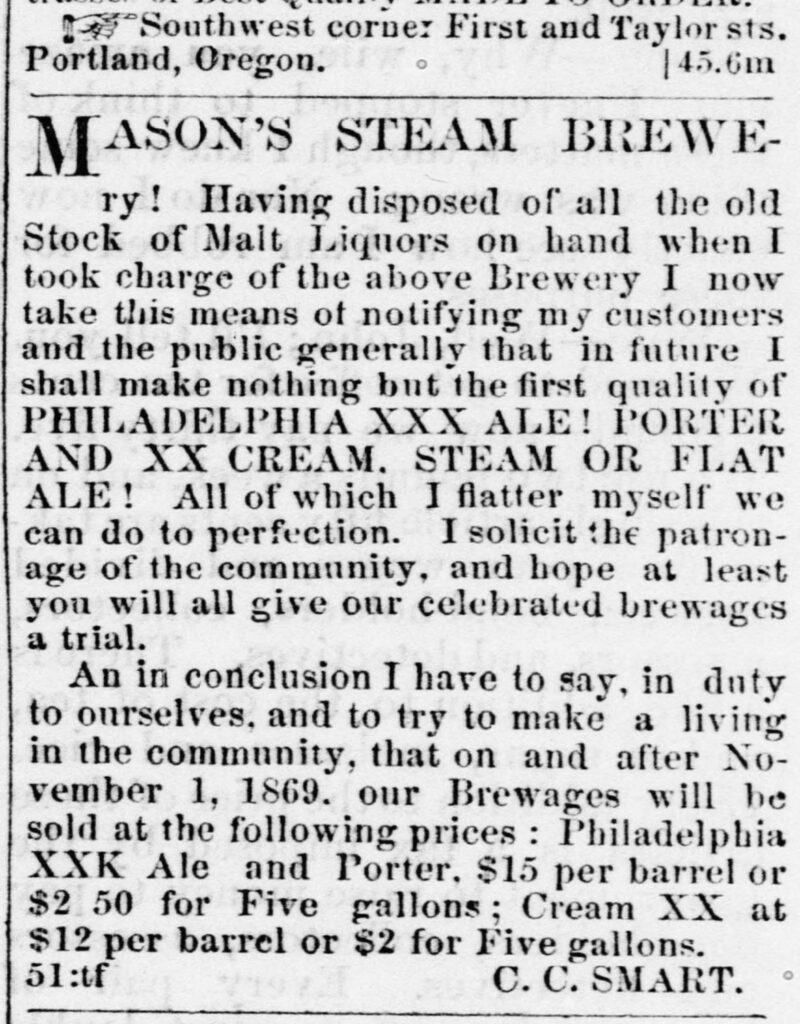
This is clearly identical to the “high cask and low cask” method of serving porter and stout, with the bartender serving customers glasses of beer filled from two separate casks, one filled with beer in high condition because it had been krausened, that is, primed with an addition of still-fermenting wort, and the other in low condition. Confirmation of the existence of “flat beer” alongside steam beer comes in two advertisements for the Oregon Steam Brewery in Portland in 1869/70 for “steam or flat ale” and “Flat Ale and Beer”.
Other early steam beer breweries, according to One Hundred Years of Brewing, were founded in 1858 in Yreka, yet another Gold Rush town, this time in the far north of California; in Oakland; and in Sacramento. But while One Hundred Years of Brewing calls them steam beer breweries, in contemporary advertising, like the ad Frederick Walter of the brewery in Weaverville issued in 1858, the brewers called their product “lager beer”.
(At 6,200 feet up, incidentally, Riehm’s brewery, and its several rivals in Virginia City – Herrmann mentions the Washington brewery, the Philadelphia brewery, the Union brewery and the Bavaria brewery – were far from being the highest above sea level: the Bodie Steam Beer Brewery in the eponymous Californian gold mining town, operating in 1908, was 8,400 feet/2550metres up in the Sierra Nevada mountains, where water boils at 91ºC/191ºF.)
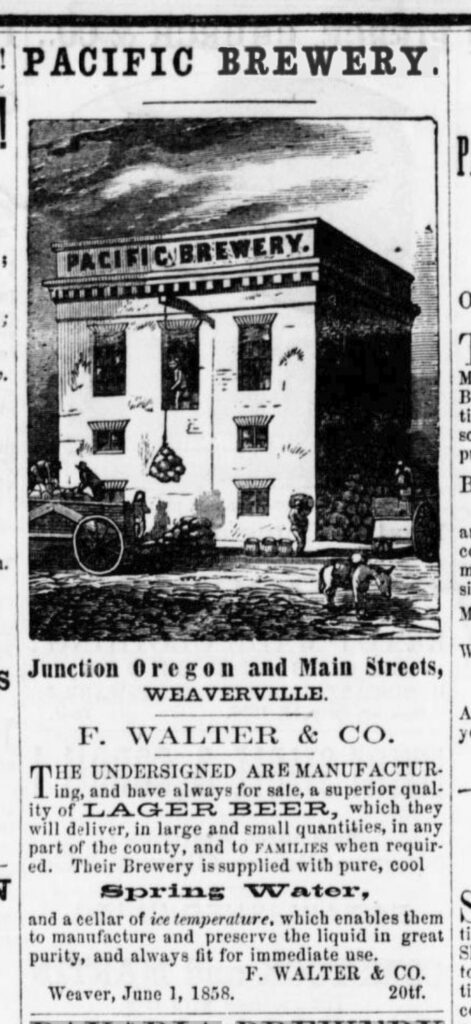
One early steam beer brewery, according to One Hundred Years of Brewing, was actually in what was then Washington territory, 600 miles north of San Francisco, at Walla Walla. One Hundred Years of Brewing claimed the City brewery in Walla Walla had been started by Emil “Meier” in 1855: this must be wrong, because Walla Walla did not exist as a settlement until 1858/9, and it was only the discovery of gold at Orofino, 100 miles away, in 1860 that led to the town becoming the outfitting point for miners heading into Idaho, at which time it would have been worthwhile opening a brewery. Indeed, a newspaper report in February 1954, when it was announced that the brewery was closing, agreed that it had been started by a man named John Hellmuth “about 1860”, with “Meier” arriving two years later. One Hundred Years of Brewing says the Walla Walla brewery made only steam beer until 1888, when the brewing of lager was started: again, when Emil Meyer (sic) advertised in the local newspaper in 1862, he claimed to be producing only lager.
Mentions of Flat Beer as a style, rather than beer that had gone flat, are rare, but one fascinating reference comes in an advertisement in a Californian publication called Mining and Scientific Press in 1880 for a “permanent beer tap” made by Fetterly and Dutton of Yolo, 75 miles north-east of San Francisco, which could “be used for any keg. Or be regulated to draw Steam or Flat Beer, and is self-locking when the key is taken out.”
The two-cask serve was still going in Yukon in 1898, if a letter that appeared as part of the writer Damon Runyon’s syndicated column in numerous newspapers around the United States at the end of March 1941 was correct. Recalling a bar in Dawson City 43 years earlier, Runyon’s correspondent wrote that: “The steam beer was drawn from one keg and the collar from another. Cost 50 cents.”
Apart from Hoffmann’s 1871 reference to steam beer as being around in 1864, the earliest known mention of the style comes from a report from October 1869 in a newspaper published in Gold Hill, Oregon about a “keg of steam beer” confiscated because the US Revenue stamp that was meant to be pasted across the bung inserted in the tap hole was instead stuck down in the middle of the cask head. This rare use of the term was undoubtedly because the barkeeper’s excuse to the Revenue men who confiscated the keg was that, the keg being filled with steam beer, “the effervescent beverage had forcibly oozed out around the plug and … the beer had floated the stamp from its original location and finally deposited it in the center of the head and dried up.”
That steam beer was still regarded as synonymous with lager beer is confirmed in an advertisement in the Daily Alta California of San Francisco in July 1873 by Samuel Marks and James Armstrong for their “Patent Lager Beer Cask Attachment to regulate and Liquefy Steam Beer”.
It may be the invention by Marks and Armstrong of a tap to control the high condition of steam beer that ended the need for a “two cask” serve, with barkeeps finally able to pour from a cask in “high” condition a glass of sparkling beer with a decent head of foam, rather than one of all froth. At any rate, steam beer continued to be krausened, but there appear to be almost no more references to a two-part pour.
No contemporary source gives an explanation for the name “steam beer”, but the evidence strongly points towards the high condition that the beer was in because of the krausening, which produced 40 to 60 psi of pressure or more in the casks, as being the best explanation: tapping the casks must have resulted in a loud “chuff!” as the pressure was released, and a cloud of carbon dioxide. A report in the San Francisco Examiner in July 1872 spoke of a “loud report” when the cock on a keg of “lager beer”, was accidently knocked off in a saloon in the city, followed by violent streams of beer, and concluded: “there is power enough in one keg of ‘steam’ beer to run a two-horse engine.”
Some time over the following decade Pacific Coast consumers and brewers finally recognised the differences between steam beer and “true” lager beer, so that the Oakland Daily Evening Tribune wrote in August 1885: “The ordinary or steam beer requires but one week’s time for its making, while lager must be at least four months old before it is ready for the market.” Until that year, however, not a single San Francisco brewer made “real” lager. The pioneer was the National Brewing Company on Fulton and Webster Streets, which installed a 25-ton refrigerating machine made by the Consolidated Ice Machine Company in Chicago, and set to making lager.
Despite alleged public demand for the supposedly “superior” beverage, however, steam beer still dominated the local market: in May 1887 the San Francisco Chronicle, covering negotiations between the Brewers’ Protective Association, the employers’ union, and the Beer Brewers’ and Maltsters’ Union of the Pacific Coast quoted the brewers as saying that “80 per cent of the beer brewed on this coast” was “the so-called ‘steam beer'” and only 20 per cent was lager.
The two types of beer were evidently being made by different breweries: the Sacramento Daily Record-Union, covering the same dispute, wrote at one point in May 1887 that the workers’ union had declared that “all of the lager beer brewers had been notified to discharge all non-union men in their employ immediately, and … the steam beer brewers would receive a similar notice in a few days.”
Even so, when the Buffalo Brewery opened in Sacramento in 1890, it was described by the San Francisco Call newspaper as “the first Pacific Coast brewery to ignore the manufacture of steam beer: all of its output consists of lager.”
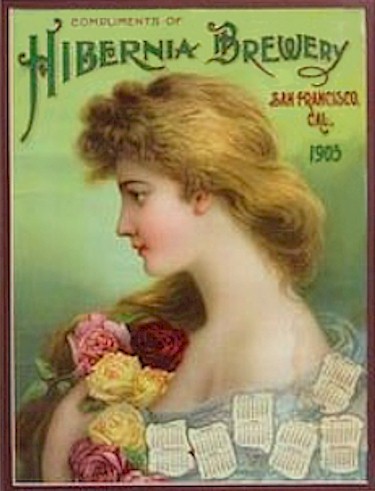
Steam beer maintained its popularity in San Francisco even after the arrival of “true” lager, however. The Hibernia brewery on Howard Street, founded in 1860, made only steam beer and porter, and was delivering more than 50,000 barrels a year in 1899, making it the largest steam beer brewery in the city. A survey after the great 1906 San Francisco earthquake, which resulted in 14 of the city’s 24 breweries being destroyed in the fires that had followed the shakings, found that 14 breweries made steam beer, against 11 that make lager.
Meanwhile steam beer brewing had spread not just as far south as Los Angeles, where Maier and Zobelein of the Philadelphia brewery on Aliso Street, founded in 1875, were advertising steam beer and lager in 1887, and into Nevada, where Jacob Klein established a steam beer brewery in 1864 (according to 100 Years of Brewing) that ran right through until 1948, and Idaho, where John Krall started a steam beer brewery in Boise City in 1867. Steam beer travelled through Oregon, where Louis Feurer began making steam beer in Portland in 1877 and Washington state, where Andrew Hemrich and John Kopp of the Bay View brewery, Seattle, were brewing steam beer in 1883, and across the border into British Columbia.
In Victoria, BC the Bavaria Brewery on Fort Street, maker of steam beer, ale, porter and lager, was founded by Henry Walther and a partner named Smith in or soon after 1872. The Vancouver Ale, Porter and Steam Beer Brewery was opened on Johnson Street, Victoria by the Carter brothers, T.W. and Robert, in 1883, while by 1887 there was another steam beer brewer on Fort Street, Hasenfratz & Lawson at the City Brewery (also making lager, porter and ale). Other BC steam beer brewers include the Union brewery in Nanaimo, producing steam beer, lager, ale and porter in 1899, and the Imperial Brewing Company in Nelson, which opened in September 1901, making lager, steam beer and porter. Vancouver’s steam beer brewers included the Lansdowne Brewery.
Steam beer even leapt two and a half thousand miles across the continent in 1891, when Gustave Proteau, who had trained as a brewer in California, went into partnership with Charles Carignan to found Proteau & Carignan in St. Paul Street, Québec, to brew ale, porter, and the “célèbre bière californienne“, steam beer.
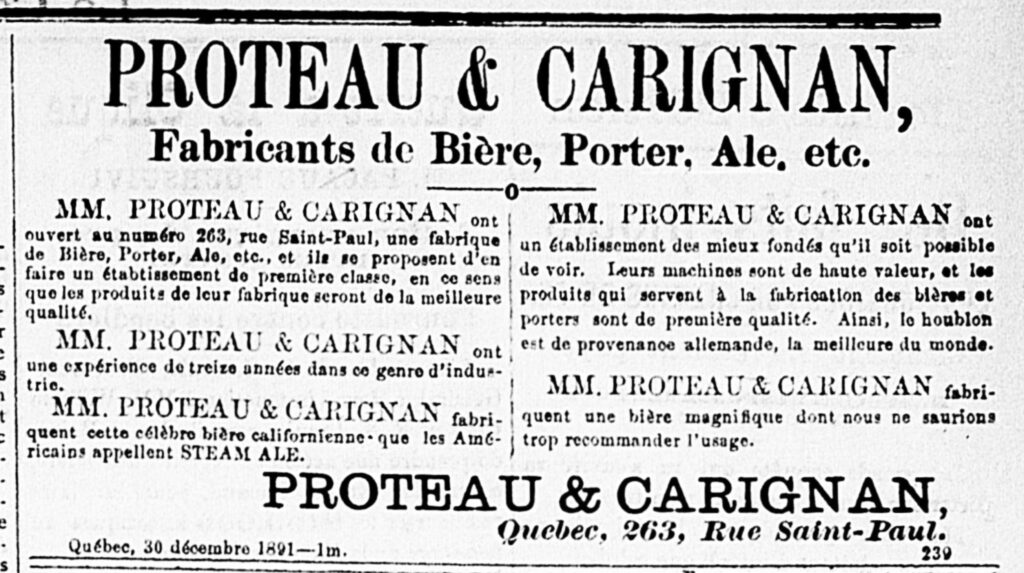
In the Alaskan panhandle, Robert Witz was brewing steam beer, lager, porter and stout in the early 1890s, while Charles A. Saake’s Skagway City Brewery and the Skaguay (sic) Brewing Co., proprietors W. F. Matlock and R. C. Smith, were both making steam beer around 1898-1900. According to Damon Runyon’s correspondent, Skagway steam beer, “light or dark”, was served at a table in a glass pitcher containing a quart of beer, for 25 cents. It was “produced and consumed at high speed. No one expected quality and no one found it.”
Skagway was the port used by prospectors heading 350 miles north to Dawson City in Yukon during the Klondike gold rush, and both Dawson City and its close neighbour Klondike City had steam beer breweries: it was reported in 1897, at the height of the gold rush, that the two breweries then operating in Dawson City “cannot supply the demand for steam beer at $125 a keg”, perhaps £3,000 today, with a glass of beer costing the equivalent of £12. The steam beer brewery in Klondike City, opened in 1904, ran until 1919, when Yukon passed a Prohibition act.
National prohibition in the United States from 1920 knocked steam beer out for 13 years, though at least a couple of Californian companies attempted to keep the flag up the flagpole. The Milwaukee Brewery of San Francisco continued to produce “Famous Milwaukee Steam Beer” throughout the crisis, albeit this was a non-alcoholic version. Meanwhile the Hayward Soda Works Co., in the eponymous city on the east side of San Francisco Bay, made Acme Steam near-beer as late as 1932. (Hayward had earlier been home to Palmtag & Heyer’s Lyons brewery, founded 1865, one of the largest steam beer breweries in California, which was producing 30,000 barrels a year in 1905.)
When Prohibition began to be eased in the spring of 1933 the Anchor brewery in San Francisco was quickly back delivering steam beer by that July, though at first only in bottles: the company had not been able to set up a cooperage in time to provide casks for draught beer.
The San Francisco Chronicle, welcoming its return, declared steam beer “distinctly Californian”, and declared, wrongly, that it was “not known in other states” (as we have seen, before Prohibition, steam beer was brewed in five other US states, and three Canadian provinces and territories). One of the first brands to return was one of the oldest: “Old Joe’s Steam Beer”, named for Joseph Hartmann, the San Jose steam beer pioneer, whose firm had survived right through until Prohibition. However, although Old Joe’s was being marketed by one San Jose-based company, the Garden City Brewing Co, it was actually contract-brewed by a third, the Fredericksberg brewery, founded by Gottfried “Fred” Krahenberg in 1856.
Other returners included the former Golden Eagle brewery on Mission Street in San Francisco, which, in was announced in April 1933, would be reopening as the El Rey brewery, specialising in steam beer; the St Helena Brewery in Napa County, which announced in May 1933 that it would be opening the following month to brew only steam beer; and the North Star steam beer brewery, on Filbert and Sansome Streets in San Francisco, which opened in February 1934 but closed the following year.
At least two new steam beer breweries were built, one for the Sonoma Valley Brewing Corporation in Santa Rosa, which opened in June 1934 – and closed before the end of the year – and the Yosemite Park Distillery and Brewing Co., in Oakdale, which was due to open in April 1934 with a capacity of 100 barrels of steam beer a day. However, just before the opening the new brewery’s management announced a change of strategy: it would now make lager beer instead. Another Santa Rosa brewery, on Second Street, founded as the Santa Rosa Steam Brewery in 1872 and running as Grace Brothers at the time Prohibition arrived, also announced, in July 1934, that it would be restarting the brewing of steam beer: “Dealers desirous to handle this product please advise soon so that the equipment for drawing this beer can be arranged.”
Despite this rush of activity, however, and despite the Anchor brewery in San Francisco being hit by a fire at the beginning of 1934 that forced it to move to the third of, currently, five homes over the decades, it was only Anchor that survived as a steam beer brewer, with Grace Brothers’ Santa Rosa brewery giving up production of the style shortly before 1950.
Now even Anchor is under threat …

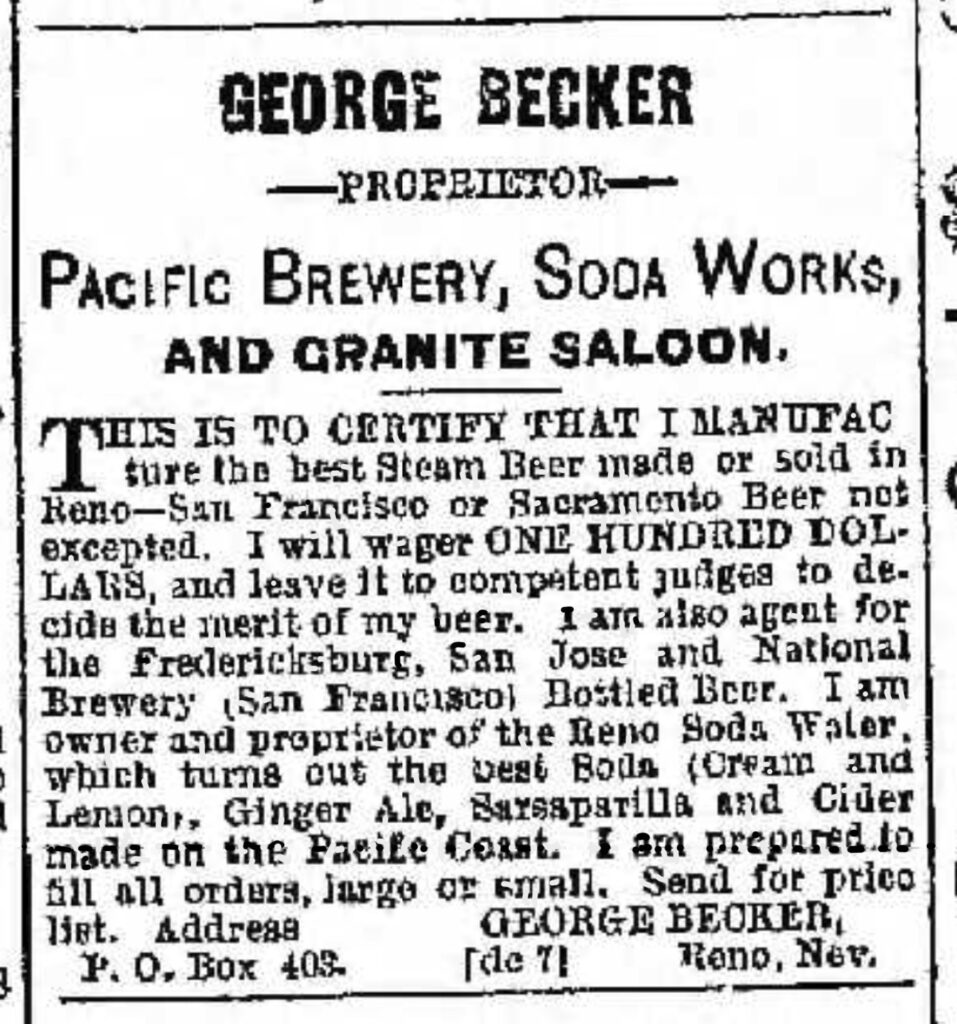

Fascinating stuff! I did a little research (emphasis on little) on beer brewed in Colorado during that 1880s gold rush. Do you have anything to share on that topic? As best I can tell, all malt bock (with lager yeast) was it.
No, I stuck strictly to the Sierra Nevada side of things …
Steam beer is the most popular beer in North Korea as they are not guaranteed electricity for the Refrigeration needed for lager brewing.
Excellent research as always. Although I never liked it very much personally, it would be sad to see the demise of Anchor.
Agreed! Steam beer and Anchor were standouts several decades ago, when all we had was mega-swill, but it’s a different world now. In the words of another beer writer, also lamenting the loss of Anchor, “What sweet summer children we must have been, to have had our palates seduced by something like Steam Beer.”
Excellent as always. It would be interesting to trace the reciprocal use of “Californian” around the same era to see if that’s the same high pressure beer sold out east as Craig noted a few years ago. http://www.drinkdrank1.com/2012/10/albany-ale-xxs-and-ohs-part-2.html?m=1
Also ties into pre-lager highly krausened ales sold in the Mid-West by the descendants of an earlier wave of Germans: http://abetterbeerblog427.com/2022/01/22/addendum-cream-beer-was-once-cream-beer/
Fascinating research! When I started brewing professionally, I was in the town of Hollister CA, about 90 miles south of San Francisco, and the owner of our company had an old photo of brewers and a brewery from the late 1800s or early 1900s, and the barrel in the photo was labeled as “Hollister Steam Beer”. While I’ve found a couple of mentions of this beer in San Juan Bautista newspapers, I could never find any more information on this old brewery. Classic photo, though. Brewers with handlebar mustaches, the oak cask etc.
I’m looking at my copy of 100 Years of Brewing over there on my bookshelf, secure in the knowledge that I can defend myself and stop a bullet with that dang thing!
Hang on…I just scanned the article in an aggrieved rush so I may have missed it, and if so a thousand apologies…but can’t anyone remember Newquay Steam? Quite popular in the West Country when I was a nipper, all them years ago…I’m sure they did a bitter lager and pilsner but my memory may play me false, not only that I didn’t really understand beer back then, my favourite beer was Colt 45 Malt Liquor at the time…
That wasn’t a steam beer in the sense that Californians used the expression – in fact I don’t believe it was a “steam beer” in any sense at all.
I still suspect a relationship between Steam Beer and Dampfbier, although which direction it travelled in I’m not sure!
Without any actual written evidence …
My interpretation of the Mason’s ad, which I discussed in my 2020 series on steam beer in this instalment: https://www.beeretseq.com/steaming-into-the-thirties-part-iv/ is that “more likely” than not, C.C. Smart brewed at Mason’s in 1869 by top-fermenetation and offered both flat (still) and steam (fizzy) versions of his Cream XX ale. I believe, from my own extensive review, that early in steam beer history the beers offered could be lager or ale. Kentucky Common Ale, which I mention in the series, was an example of “steam” on the ale side, a krausened beer. In time though especially in California, lager yeast, in a quick-brewing process, or schenk-type, became elect for the typical steam beer. (Albeit the yeast changed so much in the process, it could not be used to ferment normal lager beer). Why that is is hard to say: maybe the lager version proved more stable, all with all. Maybe the Germans, who formed so much of the 19th century brewing corps in America, had an ingrained preference for the yeast.